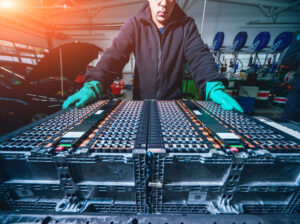Impending Shortage Means Now Is the Time to Invest in Battery-Grade Nickel

Many commodities have supply-and-demand surpluses and shortages.
Nickel is no exception.
It’s the fifth-most-common element on Earth. It occurs naturally in the form of oxides, sulfides and silicate minerals.
Nickel has many key roles in the industrial world. It has high strength, is corrosion resistant, is highly pliable, and has good thermal and electrical conductivity.
Stainless steel production accounts for two-thirds of all nickel use, but the metal has many other applications.

Today, battery manufacturing accounts for only 2% of all nickel produced. But that is about to change.
Electric vehicle manufacturers are beginning to replace the cobalt in their batteries with nickel.
Cobalt is rare and expensive. Most of it comes from Congo. And, unfortunately, much of it is mined using child labor.
Nickel delivers a higher battery energy density than cobalt. And it is cheaper and much more readily available.
This is a good thing, as we are going to need a lot more of it.
Uncertain Supply
Today, there are 142 large-scale battery plants either in operation or under construction globally. They all need nickel to make batteries.
It’s clear that the world is rapidly ramping up the electrification of transportation. As a result, the demand for battery-grade, Class 1 nickel is expected to increase to nearly 20 times today’s production levels.
That’s a huge opportunity for investors. But there’s also a level of supply uncertainty among nickel customers.
With rich sources of nickel, Indonesia has a plan to become a global leader in the EV supply chain. But last year, it decided to ban nickel ore exports.
That left a big hole in the supply. Most nickel available today is in the form of nickel pig iron, which cannot be used to make batteries. The most reliable supply of battery-grade, Class 1 nickel comes from nickel sulfide deposits.
Over the last 30 years, geologists have identified 50 major nickel deposits. Together, they hold 96.4 million metric tons of nickel contained in sulfide and oxide deposits.
The sulfide deposits are just 19%, or 18.1 million metric tons, of the total. Given the above forecast, it’s easy to see that nickel could be in short supply within a year or two.
Even Tesla (Nasdaq: TSLA) CEO Elon Musk is worried. He reiterated nickel’s importance in the company’s most recent quarterly call, saying, “I’d just like to reemphasize, any mining companies out there, please mine more nickel.”
Today’s EV batteries are generally referred to as lithium-ion batteries. But that’s a bit of a misnomer.
Most lithium-ion batteries contain just 2% lithium. Tesla’s EV battery cathodes are 35% nickel.
Best Nickel Play
What’s the best way to play the coming nickel boom? I personally like nickel miners.
The world’s largest such miner is Norilsk Nickel (OTC: NILSY). But this Russian company isn’t known for being the most reputable. It’s in the middle of trying to recover from a massive 21,000-metric-ton diesel spill.
Good alternatives to Norilsk are some of the nickel junior mining companies that trade on the TSX Venture Exchange. Most of these are small and trade for pennies on the dollar.
But savvy investors just might want to put a few hundred shares of each in their EV investment portfolios. With a nickel shortage looming, it’s just a matter of time before that investment pays off.
Good investing,
Dave






